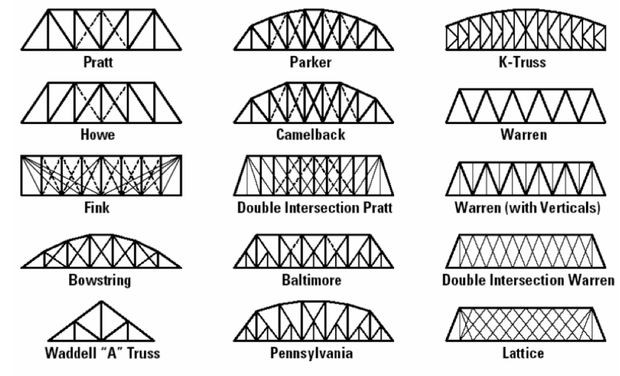Truss bridges are a popular design that are an excellent option at parks, trails, golf courses, and community spaces. Once a truss bridge is selected for the project, it brings up some frequent questions, “what types of truss bridges are there?” or “which design option will be best for this project?”. This article will help explain your options, the design’s appearance, and how you can determine which type to select.
What Type of Truss Bridges Are There?
There are many varieties of trusses; however, there are four commonly used truss-styles, including the Warren, Pratt, Howe, and K Truss. Each style contains the same basic truss structure, which includes:
- Top and bottom chords (horizontal members)
- Multiple vertical and diagonal members between the chords that are put together into triangular shapes(which helps to strengthen the bridge)
The visual difference between the styles is the arrangement of the various vertical, horizontal, and diagonal members. The top and bottom chords control how the compression and tension are distributed.
The graphic below shows what a truss design will look like when you alter the chords in different arrangements to find the required strength to match the design and loading requirements.
How does a Truss Bridge Design Impact its Performance?
When it’s time for you to select a truss-style, review what your bridge requirements include so you can choose the best style to meet your needs. Truss bridges make an excellent pedestrian bridge option, thanks to their strength and visual appeal.
Howe Truss Bridge
Member Arrangement: Diagonals face away from the bridge center.
Compression & Tension: Diagonal members are in compression. Vertical members are in tension.
Pratt Truss Bridge
Member Arrangement: Diagonals are typically parallel and slope towards the center.
Compression & Tension: Vertical members are in compression. Diagonal members are in tension.
Warren Truss Bridge
Member Arrangement: Equilateral triangles and this style doesn’t use vertical members.
Compression & Tension: Compression and tension are alternated between the members.
K Truss Bridge
Member Arrangement: Smaller length diagonal and vertical members.
Compression & Tension: Vertical members are in compression. Diagonal members are in tension. The smaller sections help to eliminate the bridge’s tension.
Examples of Areté Structures Truss Bridge Designs
At Areté Structures, our team designs truss bridges using a fiber reinforced polymer (FRP) material. Learn more about it here. FRP truss bridges are lightweight which makes them easy to transport and can be installed without heavy equipment. Below are some examples of the Howe and Pratt truss bridge designs.
Are You Ready to Start Designing Your Bridge?
Contact an Areté Structures team member to begin your truss bridge design. Do you already know what you want? Then, complete our online form to receive a quote on your bridge.

